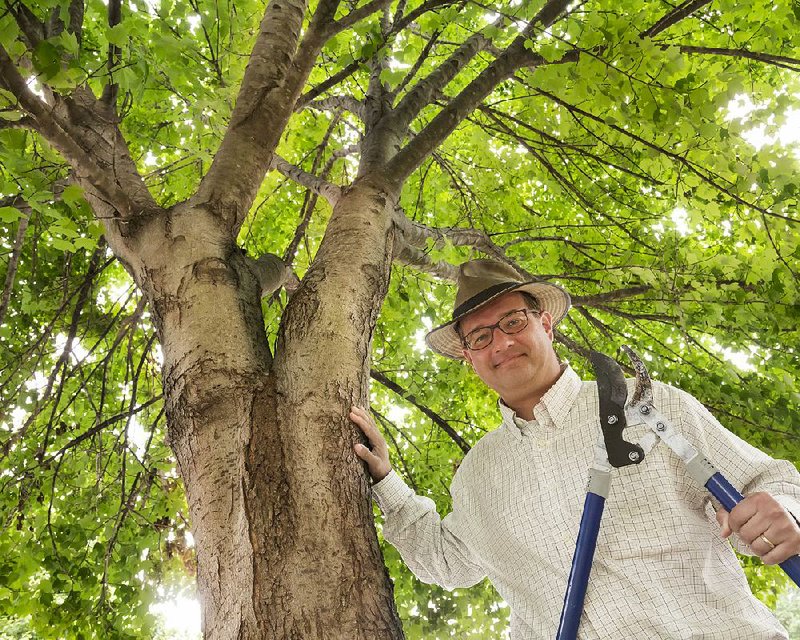John Baker doesn't exactly hug trees, but he does plant them.
Baker, 44, a member of the Mitchell Williams Selig Gates & Woodyard law firm in Little Rock, is the board president of Tree Streets, a nonprofit with a mission to plant trees in Little Rock's urban neighborhoods and educate residents about how trees benefit cities.
Aesthetics aside, trees "help cool our city and our houses, they help reduce air pollution and stormwater runoff," Baker explains. "And they help with natural habitat -- birds, those pesky squirrels, cats who want to climb them."
Baker, a Little Rock native, attended Saint Louis University (class of '94) in downtown St. Louis, where he was dismayed by the lack of trees. After he graduated from the University of Arkansas School of Law and returned to Little Rock, he and two friends agreed that "someone" should make sure this city's downtown streets didn't end up looking like those in St. Louis.
In 1997, they incorporated Tree Streets. Says Baker, "Our articles set a geographical area for the work of the nonprofit," bounded by four arteries: Interstate 630 on the north, Roosevelt Road on the south, Woodrow Street on the west and what was then McAlmont Street (now McMath Avenue), the eastern boundary of MacArthur Park, on the east -- essentially Interstate 30.
Tree Streets planted its first sapling, a red maple, at the southwest corner of 17th and Marshall streets that fall; 25 more followed shortly thereafter. In 2003, the organization planted its 500th tree (another red maple) at 16th and Park streets, across from Little Rock Central High School.
"We have been working in that area for about 20 years now. To date we have planted 1,483 trees over 175 different city blocks," Baker says. "And there's still plenty of work to do. We may have a broader geographic focus one day in the future, but for the moment, we still have a lot of work to do in [this] area."
Mostly his group plants hardwood canopy trees -- "mostly oaks, maples, tulip poplars and other species from time to time," Baker says. "We try to diversify the trees so we can make it a healthier urban forest."
Baker has served several single-year terms as president of the 16-member, all-volunteer board. "We pass the baton a little bit," he explains. "There are four offices we have to fill, so we pass them around the board. They tend to be the ones who roll their sleeves up and show up to plant and prune."
Volunteers get together to plant and prune Saturdays in fall, winter and early spring. "In recent years, we start planting trees in December and continue through January [and] February until we have planted that year's allotment," Baker says. "It varies year to year -- as few as 20; we planted as many as 225 one year. It depends on the project we've designated as a board and our financial strength.
"We're super-relaxed about who has to show up when. We don't really have any hard attendance requirements for Saturday work days. We only elect people to the board who have shown an interest and have shown up, because those are the people who best show an understanding of what we do." Since money does not grow on trees, funding relies on private donations.
Tree Streets came to the rescue, in a way, after a tornado cut a vast swath downtown, including in the Quapaw Quarter and MacArthur Park areas, on Jan. 21, 1999. Trees were a particular casualty.
"We were planting December and January 1999 over on Marshall and Bishop streets, and our board voted to abandon that project and go to streets that were wiped out," Baker recalls. "The big one we went to was the 2000 block of Spring Street. That was about the most beautiful block of canopy trees in the entire city -- they were amazing trees; mostly oaks -- and it was left with one, small 15-foot tree."
Today, the replacement trees are not quite 18 years old, and it'll take at least that long again before the canopy will come close to matching what it was like before, Baker agrees. "You can still see that tornado," he says. "You lose so much so fast, and it takes them a long time to get it all back."
Tree Streets doesn't plant on private property, only in the city right of way, between the sidewalk and the curb, Baker says. And for the most part, "people are really happy to receive these trees." He does, however, encounter those who, with varying expressions of dismay, don't approve.
"I'm afraid we do get that," he says. "We have people who remove our trees; we have people who come out and say, 'You can't plant there,' even though the city controls it. That happens more often than we would wish. Our practice is that if somebody tells us they do not want the tree, we respect that."
However, "A lot of people have seen the light. We've had people tell us how much less their air conditioner is running because the tree we planted is getting bigger and bigger. Trees save people money, in terms of utility costs in the summer months, in addition to the aesthetic improvement, habitat improvement and stormwater remediation.
"It takes 15 minutes to plant and mulch it, and that tree theoretically is going to pay dividends for 80-100 years. There [are] very few things in life you can take 15 minutes to do that's going to have that long-term effect.
"It is a singularly simple act that pays unbelievably great and long-term dividends. And that's why we do it. You show up, plant a block with new trees, see the tangible work [you've] done, walk away and watch the fruit from that one morning's work for the rest of your life.
"And that's a very fulfilling type of volunteer work."
More information on Tree Streets is available online at treestreets.com.
High Profile on 10/23/2016

